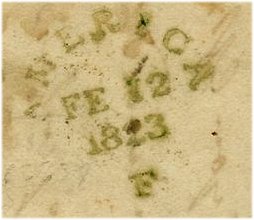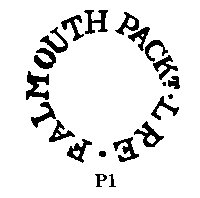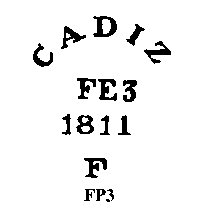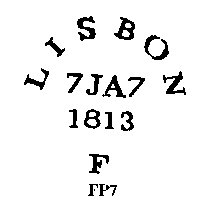Seapost -> Falmouth Packets
Falmouth Packets
By Julian H Jones
The British Government maintained a mail service from Falmouth to Corunna in Spain from 1689 [1]. However, by early 1701 it saw a pressing need to provide a regular mail service to its colonial governors in the West Indies and the Americas. In August a proposal was made by Edmund Dummer, Surveyor-General of the (British) Navy and then operator of the line of packets between Falmouth, Corunna and Lisbon. His detailed subsequent plan, drawn up in May 1702, was put before the Commissioners for Trade and Plantations and proposed a monthly service between England and the West Indies by four ships calling at Barbados, Antigua, Montserrat, Nevis and Jamaica. The Lords of Trade offered some additions including a distinct service to the American colonies. Negotiations were concluded by June 1702 and the service commenced in October, with postal rates established by Royal Warrant dated 4th December 1702 [2].
Although Dummer's service ran into many difficulties and the service closed in July 1711, it proved that a regular mail service to the West Indies was good for trade and that Falmouth was a good base from which the Post Office could operate a packet service. The Post Office resumed the West India packet service from Falmouth in November 1745 and to the other colonies on the continent of North America via New York in October 1755.
This service continued to grow with the addition of Pensacola, St Augustine and Charleston in 1764. However, relationships with colonial America brought a break between September 1775 and January 1777 (New York), and again between March 1813 and March 1815. However, from 1806 a regular service to Bermuda and Halifax, Nova Scotia, had been established from Falmouth to send mail to British North America (Canada) [3].
 With the cessation of hostilities between America and Britain a flourishing trade grew
between the two countries. The growth of vessels crossing the Atlantic gave greater
opportunity for mails to be carried by ship, and since the rates were lower, more and more
Ship Letters were carried than by packet on this route. By 1828 the Falmouth packets
were essentially driven out of the North Atlantic with the mail being increasingly carried
from 1838 by the pioneer steamships and then the contract steamers of
Cunard and other new shipping lines.
With the cessation of hostilities between America and Britain a flourishing trade grew
between the two countries. The growth of vessels crossing the Atlantic gave greater
opportunity for mails to be carried by ship, and since the rates were lower, more and more
Ship Letters were carried than by packet on this route. By 1828 the Falmouth packets
were essentially driven out of the North Atlantic with the mail being increasingly carried
from 1838 by the pioneer steamships and then the contract steamers of
Cunard and other new shipping lines.
Falmouth's packet services to the West Indies and beyond continued to grow. When Britain's old ally, the Government of Portugal, was driven into exile in Brazil by the French, a Falmouth service to Brazil was started in 1808 with a service to Rio de Janeiro calling at Madeira. This was extended to Buenos Ayres from 1813. By 1828 the GPO was offering postal rates beyond to Chile, Peru and Colombia via Falmouth. By 1837 the list included Mexico and Cuba.
Meanwhile, the Falmouth packet to Lisbon, Portugal, started in 1702, continued to flourish with services to Gibraltar and Malta from 1806 and Cadiz, Spain, and the Mediterranean from 1813. From 1835, mails for Egypt and India were made up for dispatch from Falmouth to Malta.
With this volume of mail going via Falmouth it is surprising that only a few hand stamps were made for the Falmouth Packets. Three 'India Letter Falmouth' types; three 'Falmouth Packet' types and twelve Falmouth "F" type markings exist for the postal historian to search out, between them covering the period 1802 to 1884 [4].



The above illustrations are shown by kind permission of Colin Tabeart.
However, winds of change were blowing through the postal system and the days of the Falmouth Packet per se were numbered. The Royal Mail Steam Packet Company, under contract to the British Admiralty, opened its service from Falmouth to the Caribbean and Central America in January 1842 [5] and shifted its base of operation to Southampton in 1843 [6]. The Post Office had already contracted a Packet service from Liverpool to North America starting July 1840 with the British and North American Royal Mail Steam Packet Company (Cunard Line) [7]. The Anglo - French Postal Convention additions of 1839 paved the way for mail to the Mediterranean and the East Indies to be expeditiously dispatched across France rather than via the Straits of Gibraltar [2]. The last sailing packet service from/to Falmouth ended in 1851 when the RMSPCo took over the contract for the mails to South America. Thus a noble chapter in postal history moved from Falmouth to Southampton and Liverpool, to offer even more for the postal history collector to find.
References
[1] The Transatlantic Mail, Frank Staff, 1980 edition, Quarterman Publications, Inc., Lawrence Mass
[2] United Kingdom Letter Rates, Inland and Overseas, 1635 to 1900, Colin Tabeart, Second Edition 2003,
HH Sales Limited, Bradford
[3] The Bermuda Packet Mails and the Halifax-Bermuda Mail Service 1806-1886, J C Arnell & M H Ludington, The Postal History Society
[4] Robertson Revisited, Colin Tabeart, 1997 edition,
James Bendon Ltd, Limassol, Cyprus
[5] By West India Steam Packet, Colin Tabeart, The Chronicle No 163, August 1994,
US Philatelic Classics Society, Inc.
[6] The Royal Mail Steam Packets to Bermuda and the Bahamas 1842 - 1859, M H Ludington and G Osborn, Robson Lowe Ltd. 1971
[7] North Atlantic Mail sailings 1840-75, W Hubbard and R F Winter,
US Philatelic Classics Society, Inc., 1988

